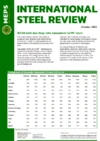Further flat product price rises doubtful in the US
Flat steel product prices in the United States appear to be at a crossroads.
Steel producers have had a great deal of success in raising their price quotations in the last three months. A combination of tightening supply and a rise in costs were the catalysts for this.
Prices continued their positive trajectory in January, but at a slower pace than in preceding months. The consensus view of US respondents in the January edition of MEPS's International Steel Review is that domestic values are nearing the peak of the price cycle.
MEPS International steel market analyst, Chris Jackson, said: "Encouraged by previous price gains, steel producers in the US may be quietly confident of one last push towards higher prices. However, there are signals that prices may have peaked.
“Numbers could be under negative pressure, sooner rather than later, especially if flat rolled buyers sense any weakness in mill order books.
“One thing is for certain; US flat product values do not historically stay stable for long."
Buoyed by the success of their previous initiatives, producers in the United States were willing to raise their price quotations further in early January. Cleveland-Cliffs officially announced a new target level of USD1,150 per short ton for hot rolled coil material. Several US participants labelled the pricing move as a defensive one, however.
MEPS understands that the majority of deals, in recent negotiations, are being struck at prices below this figure.
There is considerable doubt whether suppliers will achieve the full extent of their pricing ambitions. The majority of purchasing managers claim that they have been surprised by the sheer scale of the recent rises. They suggest that a gradual step-by-step approach would have had a better chance of long-term success. As it is, the recent price hikes are unlikely to be sustainable.
There are a number of reasons for this.
Threats to price stability
Steel demand remains solid yet unspectacular in the US. MEPS research revealed that most domestic service centres – either side of the New Year – were still in destocking mode. Owing to the rapid escalation of values, CRU-based buyers are likely to be trading cautiously, and only procuring what they need. They may be purchasing the minimum volumes required – in their contractual arrangements – ahead of a price correction in the coming months.
Activity levels in the US compare favourably with other parts of the world. Nevertheless, economic policies, implemented by the Federal Reserve to combat inflationary pressures, have restricted access to finance. Project-related activities, linked to many steel-using segments, have either been delayed or shelved, as a result.
Strip product prices have rocketed since last October, in the US. This is attributed to mills’ desire to increase values from low levels. They were supported initially in their attempts to lift figures by supply-side considerations.
Several US producers used the respective November and December holiday periods to scale down their operations; either through scheduled maintenance outages or by aligning their production capacity with current market demands.
Steel supply
Mill delivery lead times were initially extended as a result. However, most US buyers are convinced that mills’ order books are not as strong as producers are keen to portray. Delivery lead times are starting to normalise. It is reported that March delivery is typically available for hot rolled coil and April for value-added material.
Furthermore, import quotations are now back on the radar. Because of the widening price gap between local and non-North American material, some US Midwest-based buyers note that foreign HRC is becoming more attractive. Sub-USD1,000 per short ton offers are being commonly heard from Asian exporters for April delivery.
The impending reopening of the Great Lakes navigation will facilitate deals. Nevertheless, ongoing Section 232 restrictions from non-quota countries and a rise in transit costs, because of the recent geopolitical issues in the Red Sea, are discouraging factors.
Amid a lack of demand and supply support, it is becoming increasingly apparent that the pricing discipline exhibited by US mills is starting to weaken. In MEPS’s January research, most participants were divided over whether prices will be able to rise any further.
Jackson said: “MEPS believes that the recent mill pricing initiatives may not be enough to prevent price erosion during the first quarter. US prices are likely to fall in the coming months due to the unlikely prospect of any significant demand improvement in the first six months of 2024."
- Monthly insight into the US carbon steel market is published in MEPS's International Steel Review. The monthly report provides subscribers with steel prices, indices, market commentary and forecasts from across the globe.

Source:
International Steel Review
The MEPS International Steel Review is an essential monthly publication, offering professional analysis and insight into carbon steel prices around the world.
Go to productRequest a free publication





